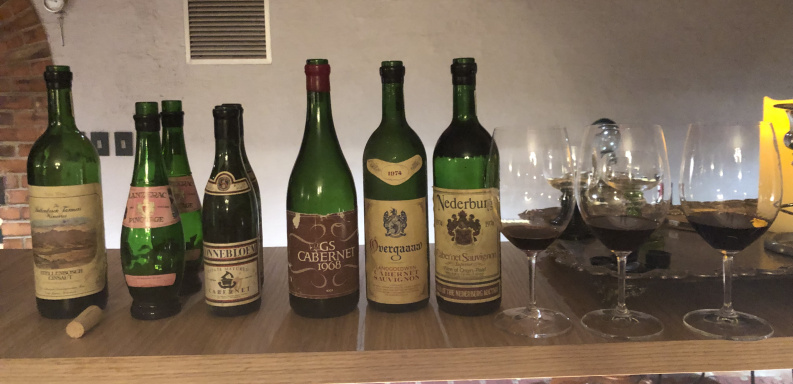The Tabernacle holds onto history and hope for the future
By Tšepang Molisana | 3rd August 2022
The Tabernacle is a sacred and storied wine library in the heart of Stellenbosch, meticulously curated by custodian, Michael van Deventer.
“There were rules, such as: stand when drinking wines that are over 25 years old, no smoking, whoever sat at the head of the table had to host, and other rules,” Michael says.

The Tabernacle is housed underground, under the networks that wind around Distell’s manufacturing operations on Adam Tas Road and has been renovated to reflect the past, preserve history and reach out to the future.
The invitation into the inner sanctum of The Tabernacle is a rare one. First formed surreptitiously and mischievously by a handful of wine fiends and fundis, including the late Duimpie (Francis) Bayly in 1979, The Tabernacle houses thousands of artefacts including bottles of wine and blending books.
Michael, who has been the custodian of The Tabernacle since 2010 (alongside his day job) says: “part of this project is translating blending books, some of which are 500 pages.”
Some of the challenges include shorthand, for instance, Michael says when seeing the letters ‘OK’ he wonders whether it represents an abbreviation or a person. He also cites not having blending books for Nederburg and moving the analyses to digital formats.
The collection housed at The Tabernacle includes two bottles of Constantia wine which date back to 1821.
At a tasting of wines in June 2022, in preparation for a July 2022 Strauss & Co auction of Tabernacle wines, some rare emblems of South African wine iconography emerged from the cellar.
The 1974 vintage was represented by the SFW Stellenbosch Cinsault, the 1974 Overgaauw Cabernet Sauvignon and the 1974 Nederburg Auction Cabernet Sauvignon. The tasting also included half bottles (375ml) of the 1963 Lanzerac Pinotage and the 1961 Zonnebloem Cabernet Sauvignon.
Sommelier, Higgo Jacobs’ passion is the driving force behind the wine auctions at Strauss & Co, in partnership with Wine Cellar.
“The demand for half bottles in the 1960’s was driven by railways and hotels. There wasn’t a demand for red wine, so half bottles were popular. This was four years after the first bottling of Pinotage in the country – the Tabernacle really does house wine history in a sense,” Higgo says.
“The 1960’s were a rockstar decade, internationally, people started to take note of South Africa and appreciate that we were making fine wine,” Higgo says.
The 1974 SFW Stellenbosch Cinsault harkens the sensibility of internationally lauded Cinsault from our current era, including the Mullineux Family Wines Cinsault.
“1974 was the start of the certification of regionality in South Africa,” Higgo asserts.
The Nederburg Auction Reserve Cabernet Sauvignon 1974 sold for R11,000 each. When renowned US winemaker Robert Mondavi tasted the wine in 1974, his declaration was: “Rapture!... Still fresh and juicy with lovely structure…. Long and lingering finish. Magnificent!”
For investors and enthusiasts alike, the wines are carefully preserved by a thoughtful recorking process at The Tabernacle’s recorking clinics, supported by Amorim. Higgo says this process makes it possible for “a buyer without the expertise and convenience to have the guarantee when opening an older bottle at home.”
The online auction attracts an audience of largely 80% locals and a 20% international audience.
Higgo Jacobs notes the cult status of some of the wines, including the GS Cabernet Sauvignon – only two vintages were made, the 1966 and 1968.
The GS Cabernet Sauvignons were considered to be made by Stellenbosch Farmer’s Winery winemaker, George Spies. They fetched by far the highest prices of any South African wines on the auction. Per bottle, the 1966 fetched an auction bid of R38,000 while the 1968 achieved R28,000.
The 1966 GS Cabernet Sauvignon is the only South African wine to have achieved a perfect score of 20/20 from UK Wine Authority, Jancis Robinson.
Michael van Deventer notes, “the initials GS are said to be those of self-taught winemaker, George Spies, who sourced the grapes from Durbanville. He was rumoured to have made the wine without the approval of his bosses at Stellenbosch Farmers’ Winery (SFW), which is why he didn’t lend it his actual name. We don’t know for sure. Not even his daughter has confirmed his relationship to the wine. What everyone agrees on, though, is that it is an exemplar of red wine excellence and longevity.”
Michael adds, “there is also talk that Spies, if he did indeed make the wine, did it the way a white wine is normally vinified, with a very short stint on the skins, and that for the first 20 years it was totally undrinkable. Whatever the case, time has transformed it into a wine of remarkable freshness and character.”
George Spies was the one-time boss at SFW of Duimpie Bayly, the South African wine icon in whose honour the auction was held.
Proceeds from the sale are intended to honour a project in memory of Duimpie Bayly, a former director of Distell who worked studiously towards developing quality standards for South African wine, amongst others.
The project intends to use archival material to preserve South African winemaking history.
“We have to make sure that this lasts for future generations,” Michael says.
